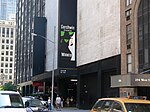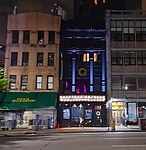50th Street station (IND lines)
1932 establishments in New York CityAccessible New York City Subway stationsEighth Avenue (Manhattan)Hell's Kitchen, ManhattanIND Eighth Avenue Line stations ... and 6 more
IND Queens Boulevard Line stationsNew York City Subway stations in ManhattanNew York City Subway stations located undergroundNew York City Subway transfer stationsRailway stations in the United States opened in 1932Use mdy dates from January 2018

The 50th Street station is a bi-level station on the IND Eighth Avenue and Queens Boulevard Lines of the New York City Subway, located at 50th Street and Eighth Avenue in the Hell's Kitchen neighborhood of Manhattan. The lower level, on the Queens Boulevard Line, is served by the E train at all times, and the upper level, on the Eighth Avenue Line, is served by the C at all times except late nights and the A during late nights.
Excerpt from the Wikipedia article 50th Street station (IND lines) (License: CC BY-SA 3.0, Authors, Images).50th Street station (IND lines)
8th Avenue, New York Manhattan
Geographical coordinates (GPS) Address Nearby Places Show on map
Geographical coordinates (GPS)
| Latitude | Longitude |
|---|---|
| N 40.762276 ° | E -73.986139 ° |
Address
8th Avenue 830
10019 New York, Manhattan
New York, United States
Open on Google Maps









